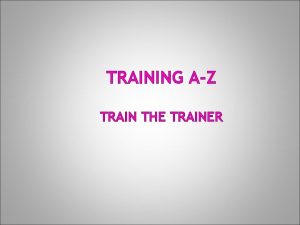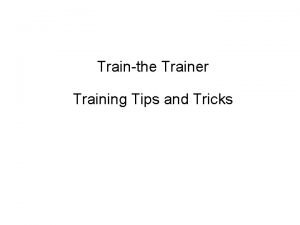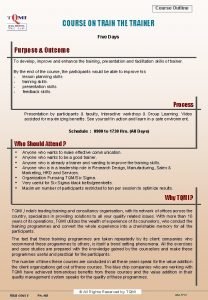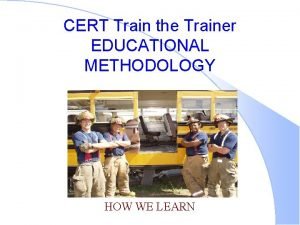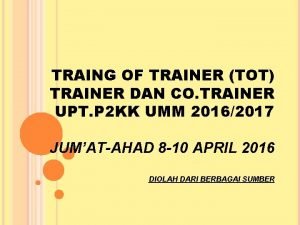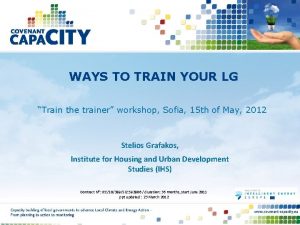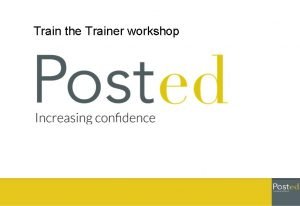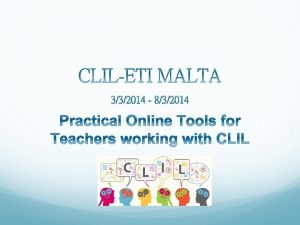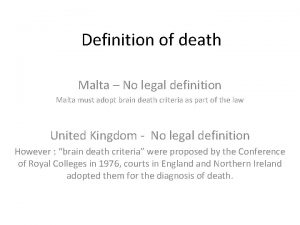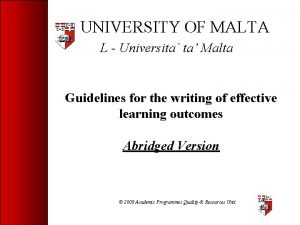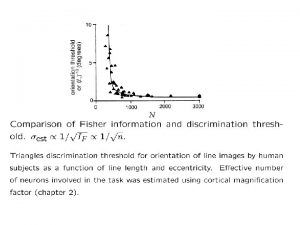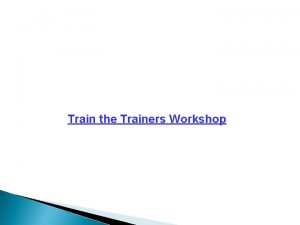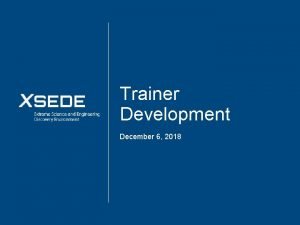Train the Trainer Workshop Train Malta July 2018













































- Slides: 45

Train the Trainer Workshop Train Malta, July 2018 Sarah Morgan sarahm@ebi. ac. uk www. ebi. ac. uk/training

Aim of course To provide new trainers with guidance and tips for developing and delivering training in bioinformatics, exploring learners motivations and needs, examining the requirements for a successful course and acquiring (and applying!) appropriate feedback. The workshop will: • provide guidance on general training techniques and appropriate use of methods based on learner needs, including some general do’s and do not’s for successful training • provide a framework for successful curriculum design and further development, to enable trainers to build training appropriate to their learner’s needs

Overview of Day - Principles of good training 1. What makes good and bad training? 2. What makes a good trainer? 3. How (and why) do people learn? 4. Designing a training session - learning aims and objectives, developing training materials 5. Delivering a training session – engaging and motivating your learners 6. Feedback - how to get it, what to do with it, how to further improve your practice 7. Final discussion and summary

About you…. • What is your prior experience of delivering teaching / training? • What are your expectations for this workshop? • Please write your expectations on a post-it note, we will revisit them at the end of the day.

Session 1: Good vs bad training and trainers

Training you have been involved in…. • What makes a good training session ? • What makes a bad training session ? • Think of an example of each that you have participated in and list your thoughts…

What makes a good trainer ? • • Knowledge of subject Clear aims for session outcomes Confidence in delivery Appropriate delivery Listens to trainees Flexible – can change pace / depth if required Approachable Engaging

Goblet TTT matrix

Session 2: How do people learn?

How do you approach learning new things?

Experiential learning: Kolb’s cycle Kolb learning cycle : Concrete experience Active experimentation Reflective observation Abstract conceptualisation

Kolb’s cycle in detail • Concrete experience – be involved in a new experience • Reflective observation – reflect on your experiences, potentially with feedback from others • Abstract conceptualisation – form and reform your ideas, integrate into theory • Active experimentation – make decisions and problem solve

Its not just the how…it’s the why! • Consider a time when you were in a learning situation…. • What was the reason behind the learning? Was it a completely new topic? • What method did you use to learn? • What was your approach to the learning? How did you organise yourself? • How did you feel as you were learning? • What were the major challenges you faced? • Did you ultimately achieve your learning goal?

7 factors for successful learning (Phil Race) • Wanting to learn • Needing to learn • Learning by doing • Making sense of it • Learning from feedback • Verbalising • Assessing • These all merge together!

Session 3 : Designing and delivering your training

Designing your training • Where would you start? • What has been your approach to designing training? • What information do you need to know?

Target audience • This may or may not be your choice ! • Consider what background knowledge the trainees may have, what they are currently doing. • At this point may want to start to think about pre-requisite knowledge • Eg Undergraduate level biology

Session aim • What is it that you are trying to provide through this session? What subject matter is to be covered? • How does this fit with the overall course aim (if applicable) • May be to teach people a particular method of analysis, or to introduce people to a new resource. • A clear aim will help when setting curriculum in more detail. • Leads into Learning Outcomes • What do you want your trainees to be able to do at the end?

Learning outcomes Should be SMART • Achievable • What ? • By trainee / trainer or both ? • Is it possible in this context • Realistic • • Specific • Measurable • Time-limited • ? Can we really train them to do this ? In what time ?

Levels of learning – Blooms taxonomy 1 Knowledge 2 Comprehension 3 Application 4 Analysis 5 Evaluation 6 Synthesis

From taxonomy to verbs…

Curriculum planning • No one set way of doing this – but if LO’s are set, then expand from these • What are the major themes which can be identified under your major course topic? • Which of these will you cover (can you cover all? ) • Will the trainees need some pre-knowledge? • Need to consider depth of learning • Think about balance of practice and theory

Learning activities • Need to keep people motivated, actively learning, engaged……. • Remember!! • People can only concentrate for short periods – often 15 – 20 minutes at most, before it drops

Most people learn…… • 10% of what they read • 20% of what they hear • 30% of what they see • 50% of what they see and hear • 70% of what they talk over with others • 80% of what they use and do in real life • 95% of what they teach someone else

Learning “activities” • What forms of learning activity can you use? Come up with a list of as many as you can think of! • How active and engaging are they? • How do they help in ensuring trainees continue to learn? 2

Developing materials • How do you build a new set of materials? • Consider setting up a new session which requires both tutorial and practical elements.

Developing materials (2) • Do you always need to develop from new? • Where can you find materials - for use or inspiration? • Can materials easily be re-used? 2

Delivering training • You have your trainees ready to go, content and materials developed…. what else do you need to consider? • Resources required to deliver the course – do you have them all? • Consider writing a trainer checklist • Setting expectations from the outset; what you will cover, how you are going to run the session • Trainees then know what to expect and how to get the most out of your session • BREAKS!!! They are needed…. . • Time for discussion

Assessing that learning is happening… • Teaching and learning do not necessarily happen at the same time…. • Short training courses do not lend themselves to formal assessments at the end, but how can you assess that your learners are taking steps forward? • Quizzes • Discussions • Q&A sessions • Short topic overviews delivered by participants • Projects • Problem solving

Session 4: Feedback

Whilst running a session - real-time feedback • Do keep an eye on your “audience” • Watch for signs that they don’t understand, or concentration is lapsing • Try and be flexible – adapting your session to suit the group as you go if possible • How can you assess where your trainees are during your session /course? • Practicals – can be useful to have someone at the back of the room !

Reflective practice • After you have completed a session: • Think about what worked well and what you were not happy with • Helps you when planning future sessions, whether the same or a different one • Don’t be too negative – remember groups vary (do think about the environment etc) • Where does you feedback come from? • Self, the room, colleagues and end of course survey

Post-course collection of feedback • Feedback from trainees can be very useful • Keep surveys short • Think about your reasons for collecting the information and what you need to collect • Mixture of closed and open questions • Think about who will have access to the results – do you need to moderate? • You should always review your feedback along with your own reflections

Final discussion

Two questions… • Have your initial expectations been met? • What one thing have you learned that you were not expecting? 3

Final activity…… • Over the next week…. • Think about what you are taking away from today’s session • What one thing did you learn that was different / new / exciting / unexpected? • What are you going to do differently next time you train? • Any other comments…. • Email me – sarahm@ebi. ac. uk

The end

Limitations / issues for Bioinformatics training • Fast changing subject, tools change quickly • Difficult to use a traditional training approach “click here” • Need to provide understanding of how tools work, and general idea of what is happening, so if a tool changes, trainees can still use it • Example datasets and appropriate exercises • Either difficult to get datasets, or need to use cut down sets, so not quite so true to life – teaching concepts, not full practical “how to”

Planning the course • Scientific and “social” elements • Scientific – in what order will you deliver the various elements of the course content • Social – coffee and lunch breaks, opportunities for networking • How long do you have to deliver the course ? • How long should your day be ? • Theory vs practice • Even in a very practical course, theoretical explanation session are helpful for scene setting

Commonly used sessions • Course welcome and introduction • Welcome your trainees, give any H+S details etc • Intro to course, aims and expectations • Start of day • Brief intro of what is to come, can check everyone is in, all happy • End of day • Quick recap, again check everyone is ok, good time for discussion • Final wrap-up session and feedback collection

Lecture – style sessions • Death by powerpoint is common ! • Try to make slides more interesting if possible • Don’t necessarily put everything on the slide you are going to say – avoids you reading off your slides! • Don’t overfill your slides and use at least a 20 point font • Build time in for questions, discussions…. .

Practical sessions • Practical handbooks important – guided exercises to follow • Can start with a demonstration, then into the guided exercise • Remember not everyone will necessarily go at the same pace • Extra time in programme for people to finish if they wish– eg lunchtimes • Have some extra exercises eg problems to solve, for those who finish • Can be difficult deciding how much time to give • Having extra demonstrators in the room to answer queries is very helpful

Group problem solving • Can be a good way of getting people talking, can also be a useful way of ascertaining how much people know • Eg Workflow exercise – what are the steps taken in a metagenomic workflow, potential limiting points in this etc • At the beginning can be useful to get people into the mindset, and help you set the scene for the course • You can refer back to this session at different points in the course, helping reinforce ideas • Especially useful in sessions where you have a high number of novices in the field

Course descriptors and advertising • Keep course descriptors concise, but consider what information people will use to choose a course. • List points to include? • Make sure it is a true representation of what you will cover, so trainee expectations can be managed / met • Advertise everywhere you can!

Applications • Methods of application can vary – e. g. CV and supporting letters or completion of online form • You need to decide on your selection criteria • Be transparent, so if someone queries you, they can be answered. • Make sure that you can get the information you need for selection from the information you have requested. • May decide on a selection committee - more than one person to review all applicants.
 On july 18 2001 a train carrying hazardous chemicals
On july 18 2001 a train carrying hazardous chemicals Train the trainer agenda
Train the trainer agenda Train the trainer course objectives
Train the trainer course objectives Trainthe trainer
Trainthe trainer Train the trainer outline
Train the trainer outline Stone avenue train station
Stone avenue train station Cert train the trainer
Cert train the trainer Que letra continua m v t m j
Que letra continua m v t m j Super saturday tribal bingo july 4
Super saturday tribal bingo july 4 June 22 to july 22
June 22 to july 22 Ctdssmap payment schedule july 2021
Ctdssmap payment schedule july 2021 2003 july 17
2003 july 17 July 30 2009 nasa
July 30 2009 nasa Leaf yeast experiment
Leaf yeast experiment July 4 sermon
July 4 sermon Miss cuba receives an invitation
Miss cuba receives an invitation Tender mean
Tender mean Mai june july august
Mai june july august Sergei korolev
Sergei korolev Sources nso frenchhowell neill mit technology...
Sources nso frenchhowell neill mit technology... The mysteries of harris burdick captain tory
The mysteries of harris burdick captain tory July 26 1953
July 26 1953 June too soon july stand by
June too soon july stand by July 12 1776
July 12 1776 Poppies in july poem
Poppies in july poem Antwrp
Antwrp July 14 1789
July 14 1789 Slidetodoc.com
Slidetodoc.com May 1775
May 1775 Captain tory harris burdick
Captain tory harris burdick July 16 1776
July 16 1776 July 2 1937 amelia earhart
July 2 1937 amelia earhart Sensory language definition
Sensory language definition July 10 1856
July 10 1856 2001 july 15
2001 july 15 Malaga in july
Malaga in july Monday 13th july
Monday 13th july Sylvia plath poppies in july
Sylvia plath poppies in july July 1-4 1863
July 1-4 1863 Respiratory specialist malta
Respiratory specialist malta Malta gastronomia
Malta gastronomia Barabas as a tragic hero
Barabas as a tragic hero Confini di malta
Confini di malta Malta football trials
Malta football trials Malta council for science and technology
Malta council for science and technology Altarius asset management
Altarius asset management

